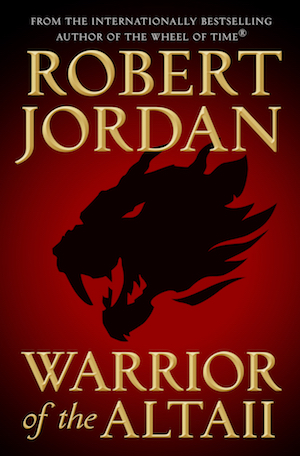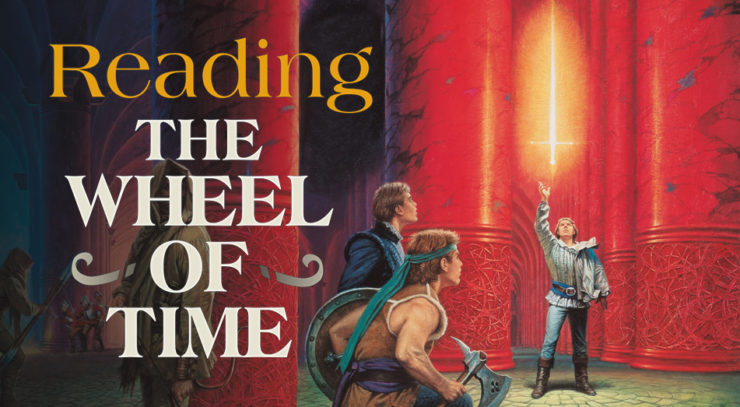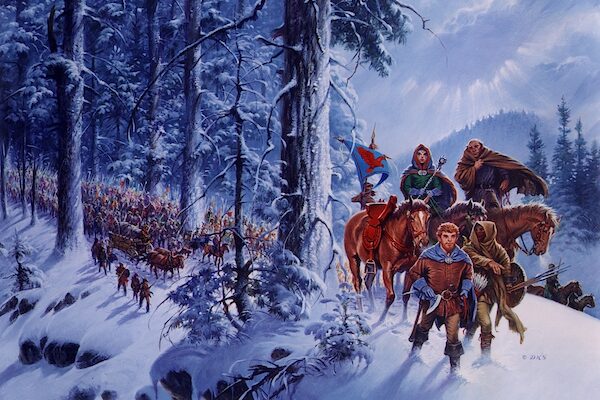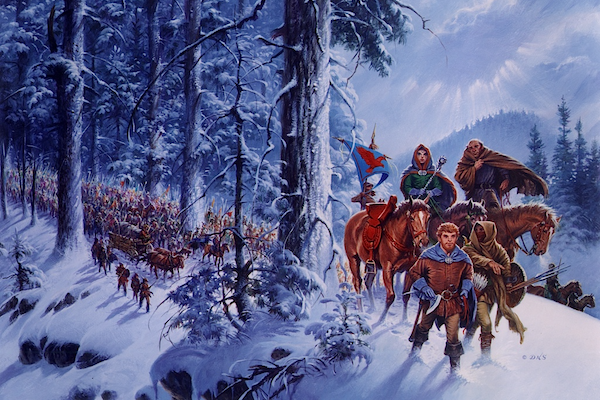So the question on everyone’s mind—and by that I mean, the question that has been on my mind—is just what it means to be ta’veren in Robert Jordan’s Wheel of Time. Though the first three books in the series are no doubt just a drop in the bucket compared to the complex development that is to come, these three novels have laid out for us a basic understanding of what the Wheel of Time is, what the Pattern is, and the role of ta’veren within the Pattern. As Rand, Perrin, and Mat are slowly learning what it means to be ta’veren, we the readers are confronting many of the same questions. So even though I imagine I’ll need to revisit this question in a few more books-worth of time, it still seemed a good moment to sit down and ask, just what is a ta’veren, anwyay?
The concept of ta’veren is first introduced to Rand, and to the readers, by Loial, when they meet at The Queen’s Blessing in Chapter 36 of The Eye of the World. Despite the fact that he has been hiding his story from everyone, Rand finds himself telling the affable Ogier everything that has happened, from the Trolloc attack on Emond’s Field right up through Thom’s “death” at the hands of the Myrddraal and Rand and Mat’s flight to Caemlyn, beset by Darkfriends on every side. Loial’s answer, after hearing the tale, is to bring up ta’veren. He asks Rand if he knows how the Pattern is woven, but Rand has never really thought about it before, so the Ogier explains.
“…You see, the Wheel of Time weaves the Pattern of the Ages, and the threads it uses are lives. It is not fixed, the Pattern, not always. If a man tries to change the direction of his life and the Pattern has room for it, the Wheel just weaves on and takes it in. There is always room for small changes, but sometimes the Pattern simply won’t accept a big change, no matter how hard you try. You understand?”
Rand nodded. “I could live on the farm or in Emond’s Field, and that would be a small change. If I wanted to be a king, though…” He laughed, and Loial gave a grin that almost split his face in two. His teeth were white, and as broad as chisels.
“Yes, that’s it. But sometimes the change chooses you, or the Wheel chooses it for you. And sometimes the Wheel bends a life-thread, or several threads, in such a way that all the surrounding threads are forced to swirl around it, and those force other threads, and those still others, and on and on. That first bending to make the Web, that is ta’veren, and there is nothing you can do to change it, not until the Pattern itself changes. The Web—ta’maral’ailen, it’s called—can last for weeks, or for years. It can take in a town, or even the whole Pattern. Artur Hawkwing was ta’veren. So was Lews Therin Kinslayer, for that matter, I suppose.”
One thing that I definitely missed in Loial’s explanation—or more likely, forgot—is the suggestion that one is not necessarily ta’veren for one’s whole life. It is difficult to say whether Rand was ta’veren when he was born, or if it came upon him at a later time, though as the Dragon he was of course always destined to be ta’veren, sooner or later. It’s also interesting to note that, as much as the idea of a Wheel spinning people’s lives like threads feels fantastical, the everyday workings of it are both logical and simple. Of course big changes are harder than small ones; whether you view that as a logical consequence of the physical world or as the direct intervention of the Pattern of Creation, the results are the same.
However, the idea of having certain people and certain lives designated to effect change on others is a more complicated concept. Even the educated characters like Loial and Moiraine aren’t entirely sure how how they work, or how the affects should be interpreted.
In Chapter 42, after the boys confess to Moiraine about their Ba’alzamon dreams, Loial realizes that it is not just Rand but all three boys who are ta’veren. Moiraine accepts the designation easily, having clearly already realized although she hasn’t yet said the words. She also explains how there are two basic ways to be ta’veren.
“For a time the Pattern does seem to be swirling around all three of you, just as Loial says, and the swirl will grow greater before it becomes less. Sometimes being ta’veren means the Pattern is forced to bend to you, and sometimes it means the Pattern forces you to the needed path. The Web can still be woven many ways, and some of those designs would be disastrous. For you, for the world.”
As far as Rand is concerned, it so far seems like he is more forced to the needed path than he is forcing the Pattern to bend to him, despite the ways in which we do see him affect it, such as in Jarra and the other cities where he causes spontaneous weddings, fires, droughts, and Whitecloaks abandoning their oaths. Although these effects are clearly a result of lives bending to accommodate the ripple from Rand’s, to me they feel more like collateral than anything, as Rand is obsessively bent to seek out Callandor, driven on by a passion that seems largely outside of himself, even though he has his own reasons to want to reclaim the not-sword from the Stone.
Buy the Book


Warrior of the Altaii
As the Dragon Reborn, it’s obvious that Rand should be ta’veren, as Lews Therin was before him, and no doubt all the Dragons were. After all, the Dragon is meant to stand as opponent to the Dark One—ta’veren are tools of the Pattern, and the Dragon is the ultimate tool.
“A tool made for a purpose is not demeaned by being used for that purpose.”
—Moiraine to Rand, Chapter 53, TEOtW
Rand’s strength as a ta’veren takes Moiraine somewhat by surprise. After spending twenty years scheming with Siuan Sanche, the only other person who knows about Gitara Moroso’s foretelling of the Dragon’s birth, Moiraine has no doubt grown used to having a great deal of control over events, and more knowledge of them than anyone else around her. But now that she has found Rand, her life is being directed by his, rather than the other way around. From the detour to the Eye of the World to Rand’s choice to seek out Callandor long before Moiraine thinks he is ready, events are spinning out in ways Moiraine could not have predicted, because of the influence and plots of the Shadow and because of Rand’s ta’veren nature allowing the Wheel to drive him.
For example, in Chapter 5 of The Great Hunt, the Amyrlin upbraids Moiraine for diverting from their plan to find the Dragon Reborn and bring him back to Tar Valon to be hidden. Moiraine explains:
“The Pattern pays no heed to human plans, Siuan. With all our scheming, we forgot what we were dealing with. Ta’veren. Elaida is wrong. Artur Paendrag Tanreall was never this strongly ta’veren. The Wheel will weave the Pattern around this young man as it wills, whatever our plans.”
The anger left Amyrlin’s face, replaced by white-faced shock. “It sounds as if you are saying we might as well give up. Do you now suggest standing aside and watching the world burn?”
“No, Siuan. Never standing aside.” Yet the world will burn, Siuan, one way or another, whatever we do. You could never see that. “But we must now realize that our plans are precarious things. We have even less control than we thought. Perhaps only a fingernail’s grip. The winds of destiny are blowing, Siuan, and we must ride them where they take us.”
It’s interesting to note here that even those with the most knowledge, Siuan and Moiraine, don’t agree on how much change they can actually affect, where the Dragon is concerned. But the question is not just how much change can be affected, how much of the future they can direct, but also what the best course is. After all, most other Aes Sedai believe that, as a male channeler and one prophesied to Break the world again, the Dragon should be gentled as soon as he is found, and that appears to be a real danger to Rand, as Egwene sees in her third trip through the ter’angreal during her trials to become Accepted. Moiraine is fully aware that, ta’veren or not, there are many ways in which Rand could be thwarted in reaching his destiny. His power to shape the Pattern does not mean that one outcome is in any way assured.
And indeed, Moiraine sometimes actively tries to use the ta’veren abilities of the boys, such as when she brings them all to the Eye of the World, suggesting that placing “three centerpoints of the Web” where the danger is may have an effect on how the Pattern is woven. She indicates a similar intention in Illian, when she leaves Lan behind with the boys after the Gray Man attack in Chapter 42 of The Dragon Reborn. She tells him that if she dies, he should take Perrin with him back to the White Tower.
“…It seems the Shadow has made his importance in the Pattern known to me, if not clear. I was a fool. Rand is so strongly ta’veren that I ignored what it must mean that he had two others close by him. With Perrin and Mat, the Amyrlin may still be able to affect the course of events. With Rand loose, she will have to.”
Just as the future is not assured even by the strongest ta’veren presence, it’s also possible to be driven by something other than the Pattern, as both Lan and Moiraine recognize. Even before anyone has brought up the word ta’veren, Lan recognized the focus of the Pattern upon the three Emond’s Field boys. In Chapter 38 of The Eye of the World, when he and Perrin are talking about Elyas, Lan mentions the incredible chance that the two of them, both possessed of this strange ability, should meet. “The Pattern is forming a Great Web,” he tells Perrin, “what some call the Lace of Ages, and you lads are central to it. I don’t think there is much chance left in your lives, now.”
However, this does not necessarily mean that Perrin and the others are ta’veren, as Lan points out when he wonders whether they have been chosen for something, and if so, by the Light or by the Shadow. In fact, the Dark One’s ability to touch the Pattern comes up from time to time in all three books, as Moiraine continually wonders if the broken seals have allowed him enough freedom to do so, and tries to decide if the forces driving them along are those of the Dark or the Light. When she learns about the boys’ dreams of Ba’alzamon, in Chapter 42, she explains that it is impossible for the Dark One to select out an individual except by chance, or if that person seeks it. However, “… for a time, at least, [Perrin, Rand, and Mat] are central to the Pattern. A Web of Destiny is being woven, and every thread leads straight to you.”
This is how the Dark One is able to find them, and we later see that some humans also have the power to see the ability, as the Amyrlin does when she encounters Rand at Fal Dara in the beginning of The Great Hunt.
“… he blazed like the sun. I’ve seldom been afraid in my life, but the sight of him made me afraid right down to my toes. I wanted to cower, to howl. I could barely speak.”
That sounds pretty distracting! With Perrin, on the other hand, the ta’veren effects are a little less clear. As Lan posits, it may very well be something to do with being a wolfbrother—perhaps that old skill is meant to return to the world, and Perrin is meant to herald it or help it along. Or perhaps the wolves will have a crucial role in defeating the Darkness in the Last Battle. Perrin also has a lot of individual connections with people. His push and pull with the Tuatha’an has always felt to me like it is leading to something important, and he has now drawn Faile into his orbit, much in the same way Min and Elayne seem to have been drawn into Rand’s. Still, a lot of what it means for Perrin to be ta’veren remains less clear, and Moiraine is apparently not sure what to make of him or his various abilities.
But of the Two Rivers boys, I would have to say that Mat is the one who has become the most interesting, as far as ta’veren powers go, and he is the one who really sparked my interest to ask questions about ta’veren in this piece. His abilities have come on suddenly and strongly, and while Rand seems to affect people, their choices and desires, as well as the natural world (fires, etc.) Mat actually affects chance and probability itself.
And I have to say, that’s kind of genius. If you think about it, fate/destiny and chance/luck are basically opposites of each other. By being a focal point, like a lucky charm for the Pattern itself, Mat turns chance and luck into something more deliberate. He actually creates destiny. In this way, he is more the former of the two types of ta’veren Moiraine mentioned: He drives change by his choices, and at least appears to have a lot more freedom than Rand and Perrin in what he decides to choose. His luck may have led to him overhearing the plot to murder Elayne and the others, but he wasn’t compelled to do anything about it other than by his own heart. His choice to rescue Aludra appears to have been his own, for all it turned to a very fortuitous result, and there is nothing tying him to Thom the way that Perrin is tied to Faile—he just likes the old gleeman a lot. And that, I think, is very interesting.
Of course, Moiraine hasn’t interacted much at all with Mat since The Eye of the World, so she doesn’t know about any of this. However, I think comparing her situation to Mat’s actually has helped me define the difference between someone who is ta’veren and someone who is integral to the Pattern, but not quite in that way. Perhaps the Pattern did choose that Siuan and Moiraine would be the two to witness Gitara Moroso’s foretelling, but it doesn’t seem like anything but the women’s own beliefs and determination drove them to go down the path they chose. Moiraine believes in what she’s doing, with all her heart; for all Rand’s abilities, without her choices he would almost certainly never have lived to proclaim himself the Dragon Reborn.
And the same is true for Nynaeve and Egwene and Elayne, I think. They are clearly critical to the future of the Pattern, even if they are not ta’veren, and even putting aside the ways in which they might be important specifically because of their connections to Rand. Being ta’veren is not the only way to shape the future; I will be interested to see how the efforts of these Aes Sedai-to-be compare to the efforts of the three ta’veren boys, and if the ability to affect change, or a specific type of change, can belong only to one or the other. After all, there are limits placed on ta’veren, their choices can be more restricted, and thus the effects they leave behind them are more restricted too.
I want to take this moment to thank you all for joining me in Reading the Wheel of Time! The Dragon Reborn was a blast, and I’m really looking forward to tackling The Shadow Rising. What new baddie will rise up to take Ishamael’s place? How will Rand handle his new prestige and oncoming madness? And what are Lanfear’s true intentions? Tune in on August 20th to find out!
Sylas K Barrett is very much looking forward to continuing this journey into The Wheel of Time, and is still wondering if dragons are a mythical creature in that universe, or if they once existed, or if, perhaps, they still exist somewhere.












